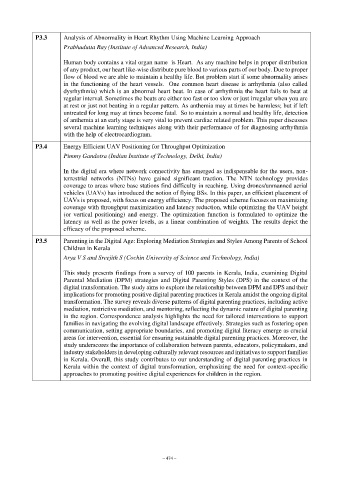Page 518 - Kaleidoscope Academic Conference Proceedings 2024
P. 518
P3.3 Analysis of Abnormality in Heart Rhythm Using Machine Learning Approach
Prabhudutta Ray (Institute of Advanced Research, India)
Human body contains a vital organ name is Heart. As any machine helps in proper distribution
of any product, our heart like-wise distribute pure blood to various parts of our body. Due to proper
flow of blood we are able to maintain a healthy life. But problem start if some abnormality arises
in the functioning of the heart vessels. One common heart disease is arrhythmia (also called
dysrhythmia) which is an abnormal heart beat. In case of arrhythmia the heart fails to beat at
regular interval. Sometimes the beats are either too fast or too slow or just irregular when you are
at rest or just not beating in a regular pattern. As anthemia may at times be harmless; but if left
untreated for long may at times become fatal. So to maintain a normal and healthy life, detection
of anthemia at an early stage is very vital to prevent cardiac related problem. This paper discusses
several machine learning techniques along with their performance of for diagnosing arrhythmia
with the help of electrocardiogram.
P3.4 Energy Efficient UAV Positioning for Throughput Optimization
Pimmy Gandotra (Indian Institute of Technology, Delhi, India)
In the digital era where network connectivity has emerged as indispensable for the users, non-
terrestrial networks (NTNs) have gained significant traction. The NTN technology provides
coverage to areas where base stations find difficulty in reaching. Using drones/unmanned aerial
vehicles (UAVs) has introduced the notion of flying BSs. In this paper, an efficient placement of
UAVs is proposed, with focus on energy efficiency. The proposed scheme focuses on maximizing
coverage with throughput maximization and latency reduction, while optimizing the UAV height
(or vertical positioning) and energy. The optimization function is formulated to optimize the
latency as well as the power levels, as a linear combination of weights. The results depict the
efficacy of the proposed scheme.
P3.5 Parenting in the Digital Age: Exploring Mediation Strategies and Styles Among Parents of School
Children in Kerala
Arya V S and Sreejith S (Cochin University of Science and Technology, India)
This study presents findings from a survey of 100 parents in Kerala, India, examining Digital
Parental Mediation (DPM) strategies and Digital Parenting Styles (DPS) in the context of the
digital transformation. The study aims to explore the relationship between DPM and DPS and their
implications for promoting positive digital parenting practices in Kerala amidst the ongoing digital
transformation. The survey reveals diverse patterns of digital parenting practices, including active
mediation, restrictive mediation, and mentoring, reflecting the dynamic nature of digital parenting
in the region. Correspondence analysis highlights the need for tailored interventions to support
families in navigating the evolving digital landscape effectively. Strategies such as fostering open
communication, setting appropriate boundaries, and promoting digital literacy emerge as crucial
areas for intervention, essential for ensuring sustainable digital parenting practices. Moreover, the
study underscores the importance of collaboration between parents, educators, policymakers, and
industry stakeholders in developing culturally relevant resources and initiatives to support families
in Kerala. Overall, this study contributes to our understanding of digital parenting practices in
Kerala within the context of digital transformation, emphasizing the need for context-specific
approaches to promoting positive digital experiences for children in the region.
– 474 –

